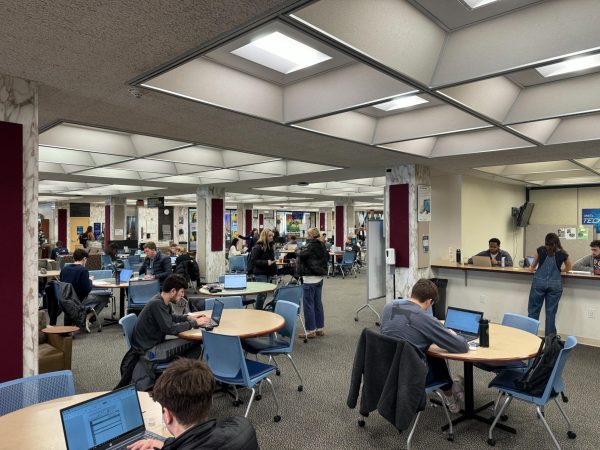Students explore 3-D printing at Solidworks demonstration
November 10, 2015
Innovation, creativity and entrepreneurship. These three inspiring words compose the slogan of Villanova’s ICE program—a program designed to spur Villanovans’ creative minds to action. Through competitions, initiatives, programs, presentations, and much more, the ICE program creates a space in which all Villanova students can share, develop, and bounce their ideas around. At the center of this learning-crazed buzz lies the brand new Idea Accelerator.
Located in the basement of the Falvey Memorial Library, the Idea Accelerator offers students an open-floor in which they can learn about cutting-edge initiatives and build on creative ideas. The ICE program hosts a number of presentations in the Idea Accelerator that are intended to inform and excite students about the endless opportunities that span each college. Each presentation is open to the general Villanova population and focuses on a certain topic that exhibits the impressive and ingenuous activities in which many Villanova students partake.
This past week, Will Landis and Elizabeth Tyhacz of the College of Engineering held a workshop on Solidworks in relation to 3-D printing, an innovative process that has recently made its way onto Villanova’s campus. Solidworks is a computer-aided design program that enables the creation of three dimensional parts and assemblies in a virtual workspace. These digital models can be transmuted to a 3-D printer, and the printer can successfully create the designed object from scratch. Clearly, this process is a game-changer when it comes to automated design and production, especially on a potentially household level. And, 3-D printing is a brand new concept, reaching only a couple years back.
Engineering student Will Landis remarked on the value of Solidworks as a learning tool for students: “Solidworks offers students a quick and easy way to digitally prototype. It enhances their creativity.” In essence, Solidworks can take the place of pen and paper in modeling sketches. It provides students with an easy-to-use interface that enables all kinds of sketching, dimensioning and building options. For engineers who learn to design practical objects, this program proves invaluable. It is exactly the type of program that engineering firms utilize in their design projects; using Solidworks effectively prepares students for a career in engineering. In fact, students are using the program now. Sophomore mechanical engineering students, for example, design small robots on Solidworks and then go into the shop and create the robots according to their design. This proves a semester-long project that culminates with each group’s robot fighting in the program’s final competition.
Solidworks’ true value emerges when used in accordance with 3-D printing, a new and revolutionary method of printing. Introduced only a couple years ago, 3-D printing enables the completely automated production of an object for a relatively inexpensive cost. The printers take a digital model (such as one designed in Solidworks) and translate it into a physical object composed of either plastic or metal. The printer contains lasers that are used to heat a reserve of material, and this molten material is laid down in layers as thin as 0.1 millimeters to create the object. When dried, the layered sheets comprise the final product. While it may seem a complicated and expensive process, 3-D printing is being improved rapidly. The machines are becoming cheaper, so much so that anyone could buy one for his or her home. The printers can create more and more complicated objects—recently, a 3-D printed car was produced. About 80 percent of the car is 3-D printed, and it runs as effectively as a standard automobile.
3-D printing’s greatest use perhaps lies in prototyping. Models can be designed quickly and accurately on a program like Solidworks, and a physical representation can be completed in only a couple hours by the printer. This results in higher-quality models created at a faster pace, which will drastically improve the design process in both academia and industry. Other uses for 3-D printing include the creation of hyper-specific, unique parts for medical devices. These devices are unique to the patients, and even the most minute details can determine the success or failure of the device in the patient’s body. For this reason, 3-D-printed objects may see a large future role in biomedical engineering.
Here at the University, 3-D printing is becoming integrated into various modes of learning both in and out of the classroom. The University owns two printers, each of which builds with plastic. However, the printer in CEER is of much higher quality—it costs about $40,000. The MakerBot, the other printer located in the Idea Accelerator, prints lower quality objects, but it can be used for free by any student at essentially any time. University students have been taking advantage of the new 3-D printers over the past year. Landis and Tyhacz have designed numerous objects in Solidworks and printed them using both printers. They have created items from phone cases and Christmas ornaments to technical flow tubes for a chemical engineering class. The two engineering students are even hosting a competition—the two best designed Solidworks pieces by any student will be printed for free on the better of the 3-D printers.
The possibilities presented by Solidworks in conjunction with 3-D printing are endless. Students in all majors can use the program for design, expanding its scope from engineering projects to arts and crafts to simple entertainment. Whichever way Solidworks and 3-D printing are used on campus, they will continue to play a major role in the production, design, and engineering fields—and they will certainly continue to promote innovation, creativity, and entrepreneurship.











